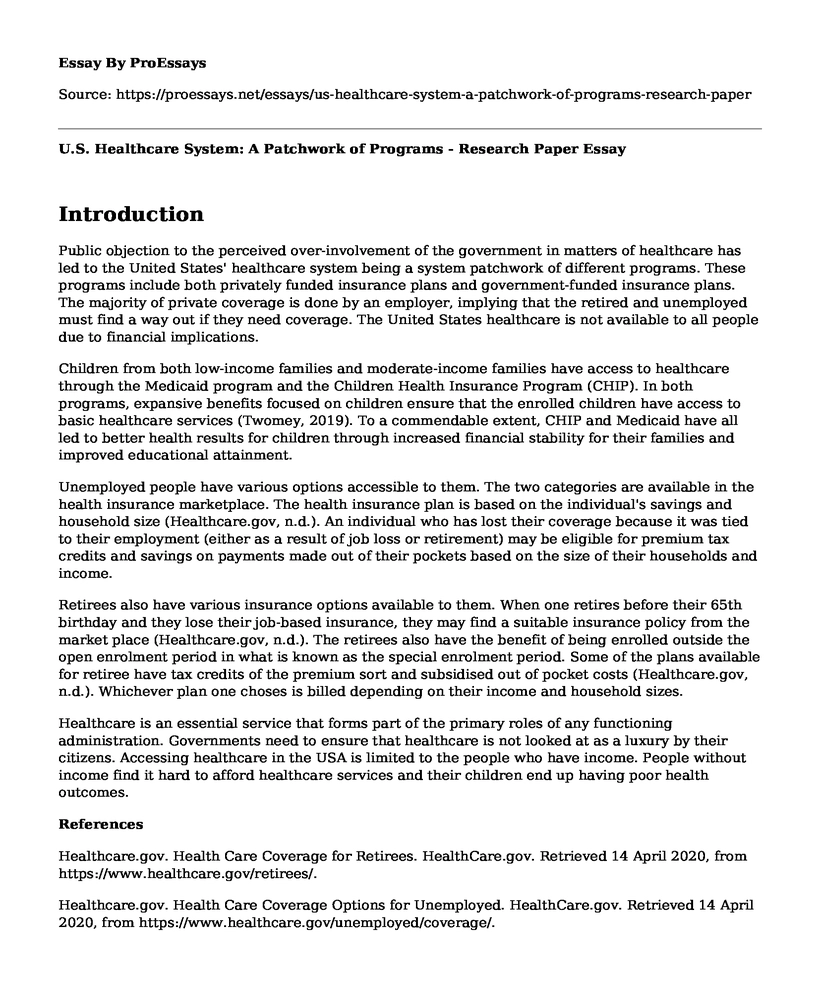Introduction
Public objection to the perceived over-involvement of the government in matters of healthcare has led to the United States' healthcare system being a system patchwork of different programs. These programs include both privately funded insurance plans and government-funded insurance plans. The majority of private coverage is done by an employer, implying that the retired and unemployed must find a way out if they need coverage. The United States healthcare is not available to all people due to financial implications.
Children from both low-income families and moderate-income families have access to healthcare through the Medicaid program and the Children Health Insurance Program (CHIP). In both programs, expansive benefits focused on children ensure that the enrolled children have access to basic healthcare services (Twomey, 2019). To a commendable extent, CHIP and Medicaid have all led to better health results for children through increased financial stability for their families and improved educational attainment.
Unemployed people have various options accessible to them. The two categories are available in the health insurance marketplace. The health insurance plan is based on the individual's savings and household size (Healthcare.gov, n.d.). An individual who has lost their coverage because it was tied to their employment (either as a result of job loss or retirement) may be eligible for premium tax credits and savings on payments made out of their pockets based on the size of their households and income.
Retirees also have various insurance options available to them. When one retires before their 65th birthday and they lose their job-based insurance, they may find a suitable insurance policy from the market place (Healthcare.gov, n.d.). The retirees also have the benefit of being enrolled outside the open enrolment period in what is known as the special enrolment period. Some of the plans available for retiree have tax credits of the premium sort and subsidised out of pocket costs (Healthcare.gov, n.d.). Whichever plan one choses is billed depending on their income and household sizes.
Healthcare is an essential service that forms part of the primary roles of any functioning administration. Governments need to ensure that healthcare is not looked at as a luxury by their citizens. Accessing healthcare in the USA is limited to the people who have income. People without income find it hard to afford healthcare services and their children end up having poor health outcomes.
References
Healthcare.gov. Health Care Coverage for Retirees. HealthCare.gov. Retrieved 14 April 2020, from https://www.healthcare.gov/retirees/.
Healthcare.gov. Health Care Coverage Options for Unemployed. HealthCare.gov. Retrieved 14 April 2020, from https://www.healthcare.gov/unemployed/coverage/.
Twomey, M. (2019). Children's Health Care Access Would Improve Under Universal Coverage Plans - Center for American Progress. Center for American Progress. Retrieved 14 April 2020, from https://www.americanprogress.org/issues/healthcare/reports/2019/06/12/470996/childrens-health-care-access-improve-universal-coverage-plans/.
Cite this page
U.S. Healthcare System: A Patchwork of Programs - Research Paper. (2023, May 22). Retrieved from https://proessays.net/essays/us-healthcare-system-a-patchwork-of-programs-research-paper
If you are the original author of this essay and no longer wish to have it published on the ProEssays website, please click below to request its removal:
- Literature Review: Sobel and Laplacian CT Scan Images
- Life Before Birth in the Womb Video Paper Example
- Essay Example on Johnson and Johnson's Pharmaceuticals
- Essay on Apicha Community Health Center: Providing Quality, Affordable Care to Vulnerable Communities
- Research Paper on Nursing Profession: Impact of Medical Policies & Safe Staffing Ratio Bill
- Essay Example on Vaccination: Key to Disease Prevention & Survival
- Inflammation, Immunity & Schizophrenia: Implications for Pathophysiology & Treatment - Essay Sample







